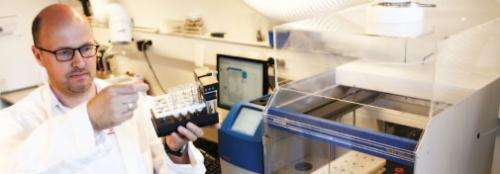Gentle chemistry for better and safer protein-drugs

A gentler new chemistry promises cleaner and subsequently far safer pharmaceuticals. The ground-breaking method, developed by a chemistry research group at the University of Copenhagen, has just been published in the internationally renowned journal, Chemical Communications, as "Site-selective three component reaction for dual functionalization of peptides".
Knud J. Jensen, the group's leader, is convinced that the method will become pivotal in the development of new pharmaceuticals. "This method opens a new chest of tools. I believe, it will be applied to pharmaceutical research right away," ensures Jensen.
Exacting work becomes easier
Knud J. Jensen is a Chemical Biology and Nanobioscience professor at the University of Copenhagen's Department of Chemistry. For the past five years, he and UCPH colleague, Associate Professor Jørn B. Christensen, have been researching methods for altering proteins and peptides, the chemical structures that run everything in the human body. Jensen asserts that protein drugs are the most rapidly growing group of pharmaceuticals.
"Protein drugs are used to combat serious illnesses such as sclerosis, leukaemia, diabetes and cancer. However, because their chemical architecture so nearly resembles the body's own structures, they are tough to work with. Or, rather – they were," says Professor Jensen.
Delicate substances require a gentle touch
Helpful new substances are traditionally concocted using rather rough methods. The contents of a test tube are typically fed a dash of powerful solvent before being boiled, under high pressure, together with some metal additives to speed along the reaction.
Natural compounds like protein based drugs can't tolerate this, explains Jakob Ewald Rasmussen, a Post Doc in the research group.
"Proteins are larger, more intricate and fragile. And, they have evolved over millions of years to function in water that is: ph-neutral, 37 degrees celcius and often without reactive metals," explains Rasmussen and continues, "It is under these delicate circumstances that the group has managed to develop new chemistry."
Two pivotal innovations
In addition to the delicate approach, the breakthrough method offers two distinct advantages. Firstly, it is a "one-pot" synthesis method. That means that the reactions occur in a single procedure. However, the method also makes it possible to attach two so-called functional groups to an individual protein. The latter sets the group's research apart and makes the method truly novel.
Two halves better than one whole
A functional group can be a coupled molecule, such as polyethylene glycol (PEG). PEG is a compound used in pharmaceuticals to extend the life of a particular drug. But it has a weakness. The compound is a long molecular chain with hard to control contents. If, however, the PEG is divided and then attached to two sites on a protein, the risk of side effects is lowered, explains Knud Jensen.
"Shorter PEG chains can be made cleaner and more uniform. This means that their medicinal effect can be made more predictable and easier to control," says the professor.
But the possibility of attaching two functional groups on a single protein also opens the door for entirely new applications.
Three...Two...One...
The new chemistry trick makes it possible to synthesise proteins with, not just two, but three functions, because the protein itself can serve a function. This means that proteins can be produced, for example, to target and stick to cancer cells. The two functional groups on a protein can then be used as a contrasting agent, so as to help discern whether a cancer is present through imaging, as well as a luminescent substance, to help guide the surgeon to a tumour's location when the patient is open and ready to be operated upon, fantasizes Jakob E. Rasmussen.
"With three functions possible in a single drug, imagination is just about the only limit," summarizes the protein postdoc.
Rapidly burgeoning line of business
Hundreds of biopharmaceutical drugs are already on the market and a peek at the number of biopharm patents reflects huge growth in the area. In 1978, 30 patents were taken out for protein-based pharmaceuticals. That number jumped to 15,600 in 1995 and shot up to 34,527 patent applications in 2001.
Journal information: Chemical Communications
Provided by University of Copenhagen



















